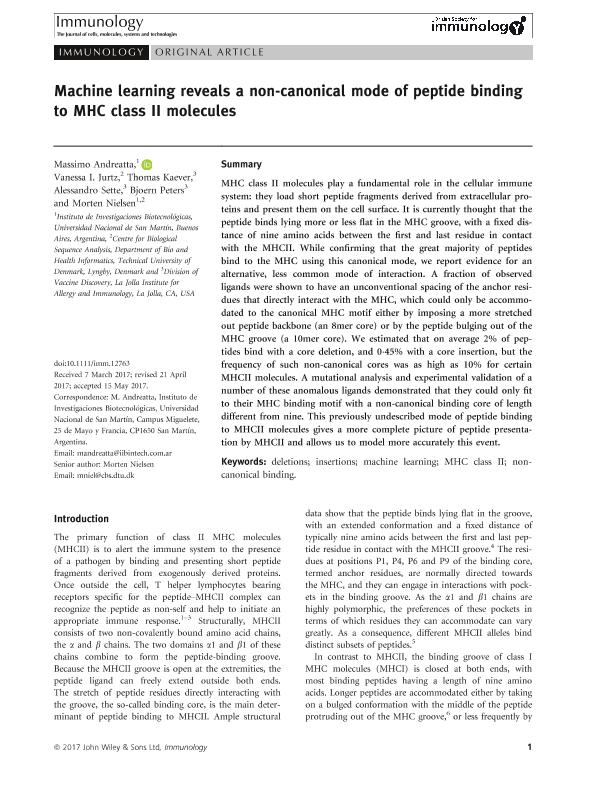Mostrar el registro sencillo del ítem
dc.contributor.author
Andreatta, Massimo

dc.contributor.author
Jurtz, Vanessa I.
dc.contributor.author
Kaever, Thomas
dc.contributor.author
Sette, Alessandro

dc.contributor.author
Peters, Bjoern

dc.contributor.author
Nielsen, Morten

dc.date.available
2018-06-14T16:15:58Z
dc.date.issued
2017-10
dc.identifier.citation
Andreatta, Massimo; Jurtz, Vanessa I.; Kaever, Thomas; Sette, Alessandro; Peters, Bjoern; et al.; Machine learning reveals a non‐canonical mode of peptide binding to MHC class II molecules; Wiley Blackwell Publishing, Inc; Immunology; 152; 2; 10-2017; 255-264
dc.identifier.issn
0019-2805
dc.identifier.uri
http://hdl.handle.net/11336/48649
dc.description.abstract
MHC class II molecules play a fundamental role in the cellular immune system: they load short peptide fragments derived from extracellular proteins and present them on the cell surface. It is currently thought that the peptide binds lying more or less flat in the MHC groove, with a fixed distance of nine amino acids between the first and last residue in contact with the MHCII. While confirming that the great majority of peptides bind to the MHC using this canonical mode, we report evidence for an alternative, less common mode of interaction. A fraction of observed ligands were shown to have an unconventional spacing of the anchor residues that directly interact with the MHC, which could only be accommodated to the canonical MHC motif either by imposing a more stretched out peptide backbone (an 8mer core) or by the peptide bulging out of the MHC groove (a 10mer core). We estimated that on average 2% of peptides bind with a core deletion, and 0·45% with a core insertion, but the frequency of such non‐canonical cores was as high as 10% for certain MHCII molecules. A mutational analysis and experimental validation of a number of these anomalous ligands demonstrated that they could only fit to their MHC binding motif with a non‐canonical binding core of length different from nine. This previously undescribed mode of peptide binding to MHCII molecules gives a more complete picture of peptide presentation by MHCII and allows us to model more accurately this event.
dc.format
application/pdf
dc.language.iso
eng
dc.publisher
Wiley Blackwell Publishing, Inc

dc.rights
info:eu-repo/semantics/openAccess
dc.rights.uri
https://creativecommons.org/licenses/by-nc-sa/2.5/ar/
dc.subject
Deletions
dc.subject
Insertions
dc.subject
Machine Learning
dc.subject
Mhc Class Ii
dc.subject
Non-Canonical Binding
dc.subject.classification
Otras Ciencias Biológicas

dc.subject.classification
Ciencias Biológicas

dc.subject.classification
CIENCIAS NATURALES Y EXACTAS

dc.title
Machine learning reveals a non‐canonical mode of peptide binding to MHC class II molecules
dc.type
info:eu-repo/semantics/article
dc.type
info:ar-repo/semantics/artículo
dc.type
info:eu-repo/semantics/publishedVersion
dc.date.updated
2018-06-13T14:57:16Z
dc.journal.volume
152
dc.journal.number
2
dc.journal.pagination
255-264
dc.journal.pais
Reino Unido

dc.journal.ciudad
Londres
dc.description.fil
Fil: Andreatta, Massimo. Consejo Nacional de Investigaciones Científicas y Técnicas. Centro Científico Tecnológico Conicet - La Plata. Instituto de Investigaciones Biotecnológicas. Universidad Nacional de San Martín. Instituto de Investigaciones Biotecnológicas; Argentina
dc.description.fil
Fil: Jurtz, Vanessa I.. Technical University of Denmark; Dinamarca
dc.description.fil
Fil: Kaever, Thomas. La Jolla Institute for Allergy and Immunology; Estados Unidos
dc.description.fil
Fil: Sette, Alessandro. La Jolla Institute for Allergy and Immunology; Estados Unidos
dc.description.fil
Fil: Peters, Bjoern. La Jolla Institute for Allergy and Immunology; Estados Unidos
dc.description.fil
Fil: Nielsen, Morten. Consejo Nacional de Investigaciones Científicas y Técnicas. Centro Científico Tecnológico Conicet - La Plata. Instituto de Investigaciones Biotecnológicas. Universidad Nacional de San Martín. Instituto de Investigaciones Biotecnológicas; Argentina. Technical University of Denmark; Dinamarca
dc.journal.title
Immunology

dc.relation.alternativeid
info:eu-repo/semantics/altIdentifier/doi/https://dx.doi.org/10.1111/imm.12763
dc.relation.alternativeid
info:eu-repo/semantics/altIdentifier/url/https://onlinelibrary.wiley.com/doi/abs/10.1111/imm.12763
Archivos asociados
